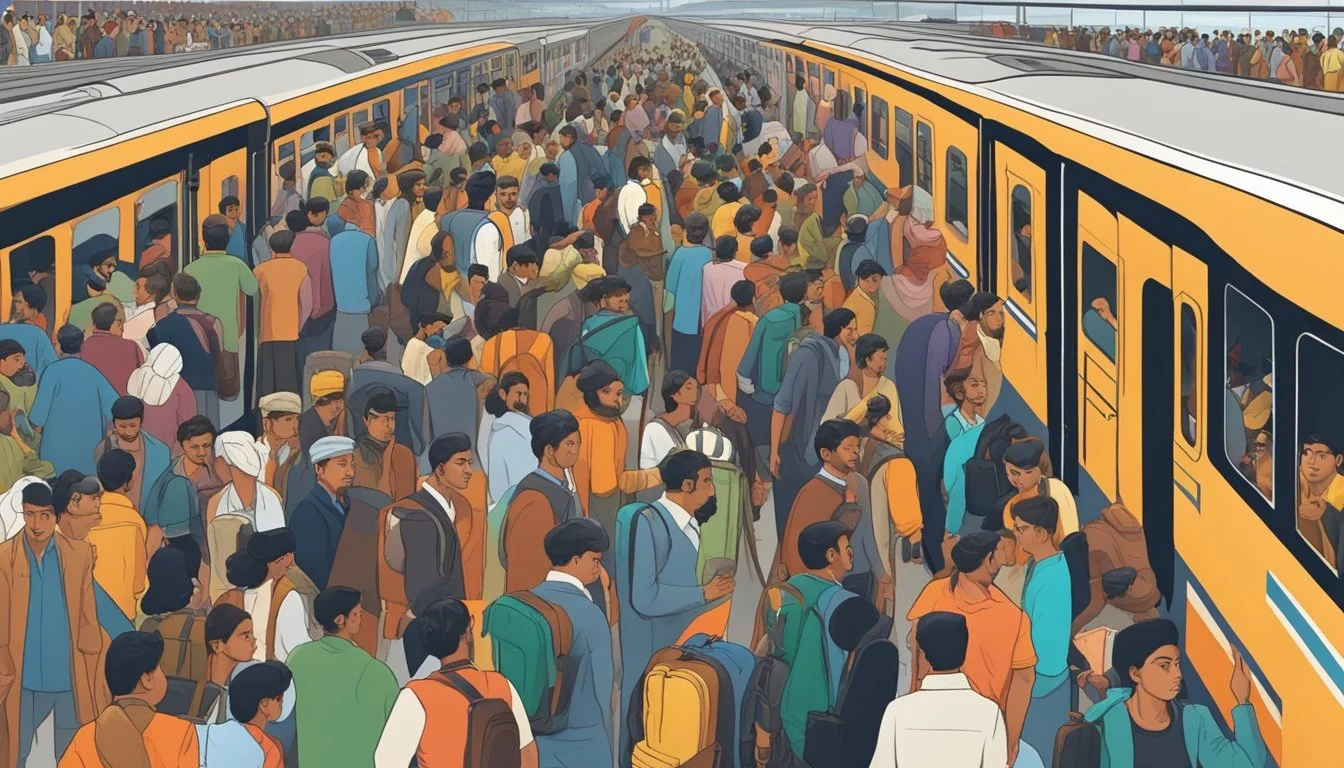5 Eye-Opening Films on the Partition of India
Cinematic Insights into a Pivotal Historical Event
The Partition of India in 1947 marked a tumultuous period in South Asian history, dividing British India into two independent nations - India and Pakistan. This momentous event uprooted millions of lives and left an indelible impact on the region's social, cultural, and political landscape.
Films have played a crucial role in depicting the human stories and historical complexities of the Partition, offering audiences powerful insights into this pivotal moment. Through compelling narratives and vivid imagery, these movies bring to life the personal struggles, communal tensions, and profound loss experienced during this time. By exploring five eye-opening films on the Partition, viewers can gain a deeper understanding of its far-reaching consequences and lasting legacy.
1) Garam Hawa
Garam Hawa, directed by M.S. Sathyu in 1973, stands as a powerful exploration of the aftermath of India's partition. The film follows the Mirza family, Muslims who choose to remain in India after the division of the subcontinent.
Set in Agra, the story centers on Salim Mirza, portrayed by Balraj Sahni. It delves into the challenges faced by those who stayed behind, grappling with questions of identity and belonging in a changing nation.
The film's narrative unfolds against the backdrop of iconic locations like the Taj Mahal and Fatehpur Sikri. These settings serve as poignant reminders of India's rich, shared cultural heritage.
Garam Hawa received critical acclaim for its honest portrayal of a complex period in Indian history. It addresses the citizenship discourse and the dual loyalties experienced by many Muslims in post-partition India.
Despite its low budget, the film made a significant impact. It faced initial censorship challenges due to its controversial subject matter but eventually gained recognition for its nuanced approach to a sensitive topic.
2) Earth
"Earth" is a powerful 1998 film directed by Deepa Mehta that explores the devastating impact of the 1947 Partition of India. Set in Lahore, the story unfolds through the eyes of Lenny, a young Parsi girl.
The film portrays the deteriorating relationships between Hindu, Muslim, and Sikh characters as tensions rise leading up to Partition. It vividly depicts how long-standing friendships and communities were torn apart by religious and political divisions.
Mehta's direction masterfully captures the growing violence and chaos engulfing the city. The film doesn't shy away from showing brutal acts committed by all sides during this tumultuous period.
"Earth" is particularly effective in illustrating how Partition affected individuals on a personal level. The central love triangle between Hindu, Muslim, and Sikh characters serves as a microcosm of the larger conflict.
Through its unflinching portrayal of this historical trauma, "Earth" offers viewers a visceral understanding of Partition's human cost. It remains one of the most impactful cinematic treatments of this pivotal moment in South Asian history.
3) Tamas
Tamas, a powerful 1988 television film directed by Govind Nihalani, stands as a poignant portrayal of the Partition of India. Based on Bhisham Sahni's award-winning novel, the film delves into the tumultuous period surrounding the 1947 division.
Set against the backdrop of riot-torn Pakistan, Tamas explores the plight of Sikh and Hindu families forced to migrate to India. The film's title, meaning "Darkness" in Hindi, aptly captures the somber atmosphere of the era.
Nihalani's adaptation brings to life the chaos, fear, and uncertainty experienced by those caught in the crossfire of political decisions. The narrative focuses on the human cost of Partition, highlighting the struggles of ordinary people uprooted from their homes.
Tamas garnered critical acclaim for its honest depiction of a pivotal moment in South Asian history. The film's unflinching approach to violence and communal tensions provides viewers with a stark reflection of the period's realities.
Through its compelling storytelling and strong performances, Tamas offers a nuanced perspective on the complexities of Partition. It serves as both a historical document and a reminder of the lasting impact of this traumatic event on the subcontinent.
4) Partition: 1947
Partition: 1947 is a historical drama that offers a gripping portrayal of the events leading up to India's independence and subsequent partition. Directed by Gurinder Chadha, the film provides a unique perspective on this tumultuous period in South Asian history.
Set against the backdrop of the final months of British rule in India, the movie focuses on Lord Mountbatten's role as the last Viceroy of India. It explores the complex political negotiations and personal relationships that shaped the partition process.
The film features a stellar cast, including Hugh Bonneville as Lord Mountbatten and Gillian Anderson as Lady Mountbatten. Their performances bring depth to the characters and highlight the internal conflicts faced by those in power during this critical time.
Partition: 1947 delves into the human cost of political decisions, showcasing the impact of partition on individuals from various backgrounds. It portrays the upheaval and displacement experienced by millions of people as borders were redrawn.
The movie's production design and cinematography recreate the atmosphere of 1947 India with meticulous attention to detail. This visual authenticity enhances the viewer's understanding of the historical context and emotional weight of the events depicted.
5) Train to Pakistan
"Train to Pakistan" is a powerful film adaptation of Khushwant Singh's acclaimed novel. Directed by Pamela Rooks, the movie offers a poignant portrayal of the Partition's impact on a small Punjabi village.
Set in 1947, the story unfolds in Mano Majra, a peaceful town near the newly formed India-Pakistan border. The film explores how the arrival of a train from Pakistan disrupts the harmony of this diverse community.
The narrative focuses on the human cost of Partition, depicting how long-standing friendships and neighborly bonds are tested by rising communal tensions. Through its characters, the movie illustrates the complexities of loyalty, love, and identity during this tumultuous period.
Rooks adopts a semi-documentary style, lending authenticity to the storytelling. The film features notable performances from actors such as Nirmal Pandey, Rajit Kapur, and Mohan Agashe.
"Train to Pakistan" stands out for its nuanced approach to a sensitive historical event. It avoids sensationalism, instead opting for a thoughtful examination of how ordinary lives are affected by large-scale political decisions.
Historical Context
The Partition of India in 1947 was a momentous event that reshaped the Indian subcontinent. It led to the creation of two independent nations - India and Pakistan - and triggered massive population movements and violence.
Pre-Partition Events
British colonial rule in India faced growing resistance in the early 20th century. The Indian National Congress, led by figures like Mahatma Gandhi and Jawaharlal Nehru, demanded independence. The Muslim League, under Muhammad Ali Jinnah, advocated for a separate Muslim state.
World War II weakened Britain's hold on India. In 1946, the Cabinet Mission proposed a federal structure for an independent India. This plan failed due to disagreements between political parties. Lord Mountbatten, the last Viceroy of India, announced the Partition plan in June 1947.
Impact on Society
The Partition resulted in one of the largest mass migrations in human history. Approximately 14 million people were displaced across the new borders. Hindus and Sikhs moved to India, while Muslims migrated to Pakistan.
Violence erupted on a massive scale. Communal riots, killings, and abductions became widespread. Estimates suggest that up to 2 million people lost their lives during this tumultuous period.
Families were torn apart, and countless individuals lost their homes and livelihoods. The trauma of Partition left deep scars on both nations. It shaped their political relations and continues to influence societal dynamics to this day.
Cinematic Techniques
Films about the Partition of India employ powerful visual storytelling and symbolic elements to convey the emotional impact of this historic event. Directors utilize distinct narrative approaches and carefully chosen imagery to bring the complex experiences of Partition to life on screen.
Narrative Styles
Many Partition films use non-linear storytelling to reflect the fragmented memories and experiences of those affected. Flashbacks and parallel timelines are common, allowing directors to contrast pre-Partition life with the chaos that followed. Some films, like "Earth" (1998), employ a child narrator to provide an innocent perspective on the unfolding tragedy. Others use ensemble casts to portray diverse viewpoints across religious and social divides.
Documentary-style techniques feature in films like "Khamosh Pani" (2003), blending archival footage with fictional scenes for added authenticity. This approach grounds the narrative in historical reality while exploring personal stories.
Use of Symbolism
Symbolism plays a crucial role in Partition cinema. Train imagery is prevalent, representing both the mass exodus of refugees and the violence that occurred during transit. The division of households and property often symbolizes the larger national partition.
Colors carry significant meaning in many films. Deepa Mehta's "Earth" uses vibrant hues to depict pre-Partition harmony, shifting to muted tones as conflict escalates. The gradual dimming of colors mirrors the loss of innocence and hope.
Natural elements like rivers and borders frequently symbolize division. In "Garm Hava" (1973), a withering tree represents a family's struggle to maintain roots in a changing landscape. These visual metaphors add depth to the storytelling, conveying complex emotions without relying solely on dialogue.





